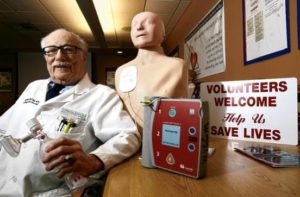DR. MAX H. WEIL, PIONEER IN CRITICAL CARE MEDICINE, DEAD AT 84

Dr. Max Weil, c. 2010
Feb. 9, 1927-July 29,2011
Max Harry Weil developed those beeping machines to monitor heart rates and other modern practices in critical-care units, transforming the treatment of stroke and heart-attack patients.
Dr. Weil, died of prostate cancer on July 29, 2011 at his home in Rancho Mirage, California. Dr Weil, opened one of the nation’s first intensive-care units, and developed the crash cart of emergency-room supplies, computerized vital-statistics monitors, and the “stat” laboratory for quick diagnostics.
Born in Baden Switzerland, Dr. Max Harry Weil lived in Germany before his family escaped Nazi rule, moving to New York City in 1936. He seemed destined to be a physician from a young age; as a boy, he liked to leave the house with a first-aid kit. He served in the U.S. Army as a medic, then attended medical school on the G.I. bill in 1952 graduating from the State University of New York Downstate Medical Center in Brooklyn. He went on to earn a Ph.D. in physiology at the Mayo Clinic in Minnesota in 1957, before moving to Los Angeles.
In 1958, Dr. Weil took a position at the University of Southern California and the next year with partner Herbert Shubin opened the Institute of Critical Care Medicine in Los Angeles. Now located at Rancho Mirage, California, and renamed for Dr. Weil, the institute has been a source of innovations in critical-care medicine including heart and pulse monitors, computer-aided medical decision-making and an automated CPR machine. Dr. Shubin died in 1975 at age 50 after suffering a heart attack while hiking in a remote area. Dr. Weil said the death devastated him and increased his commitment to providing pervasive emergency medical treatment. Dr. Weil advocated putting television cameras on medevac helicopters for remote diagnosis, teaching CPR to ordinary people and putting automatic defibrillators in health clubs and on golf courses.
Dr. Weil conceived of putting critically ill patients together in a single area where they could be tended by an interdisciplinary team of doctors, nurses, and other health professionals. “Getting all these people to talk to each other was really an art,” Dr. Lipsett said. Patients who had suffered heart attacks, strokes or were recovering from surgery were monitored much less closely when Dr. Weil started practicing medicine in the early 1950s. Many died without doctors being aware they had taken a turn for the worse. “He was among a small group of physicians who recognized that caring for the sickest patients required a change in the way care was delivered,” said Dr. Clifford S. Deutschman, the society’s president-elect and professor of anesthesiology and critical care at the University of Pennsylvania School of Medicine. “He and his colleagues changed the way medicine is practiced,” said Deutschman, adding that Weil “almost certainly is the person who coined the phrase ‘critical-care medicine.’ “He started the discipline and got it recognized as a specialty,” said Pamela Lipsett, president of the Society of Critical Care Medicine.”He developed this specialty, and he’s regarded worldwide as the father of critical care medicine,” said Dr. Wanchun Tang, president and chief executive officer of the nonprofit research and education institute. “He believed very strongly that we should be able to save more lives,” Tang said. “That’s what he was working his whole life to do.”
Dr. Weil and fellow cardiologist Dr. Herbert S. Shubin were faculty members at USC and on staff at Los Angeles County-USC Medical Center in 1958, when they began wondering why some patients died, especially at night, while apparently recovering from a heart attack, surgery or a serious illness. “As they investigated that phenomenon, they realized if we had areas where we could monitor patients intensely to make earlier diagnoses and interventions we could save lives,” said Dr. Philip Lumb, professor and chairman of the department of anesthesiology at USC’s Keck School of Medicine. “They established a four-bedded ‘shock ward'” at Los Angeles County-USC Medical Center, “an intensive-care area so patients could be looked after 24 hours a day.
Weil’s long list of accomplishments included being involved in the 1955 creation of the first bedside shock cart, a precursor to the code or crash cart of today, which holds lifesaving equipment and supplies. Drs. Weil and Shubin created the first ward for critically ill patients at Hollywood Presbyterian Hospital in 1968. Dr. Weil, who was on the faculty at USC from 1958 to 1981, was founding president of the Society of Critical Care Medicine in the early 1970s. He also was instrumental in introducing computerized patient monitors that measure a patient’s vital signs (1961) and computer-aided medical decision-making (1976), and he implemented the first “STAT” laboratory (1981), which provided quick lab results for the evaluation and treatment of critically ill patients in the ICU. Dr. Weil was also renowned as a teacher, training thousands of doctors and nurses in critical-care medicine. “My greatest joy has been an opportunity to set young physicians on the path of doing good medicine,” he said in 2006.
Even family vacations were a chance to help patients—if he saw an accident victim, Dr. Weil would insist on stopping the car to help out, including getting in the ambulance and accompanying the victim to the hospital. “We learned to carry books with us always because you could be on your way to a hospital waiting room,” said his daughter, Carol Weil.
Dr. Weil retired as president of the institute in 2006. But, Tang said, he continued to work full time until two weeks before he died.
Submitted to NEMSM on August 2011 by Mark Peck, EMT-P
